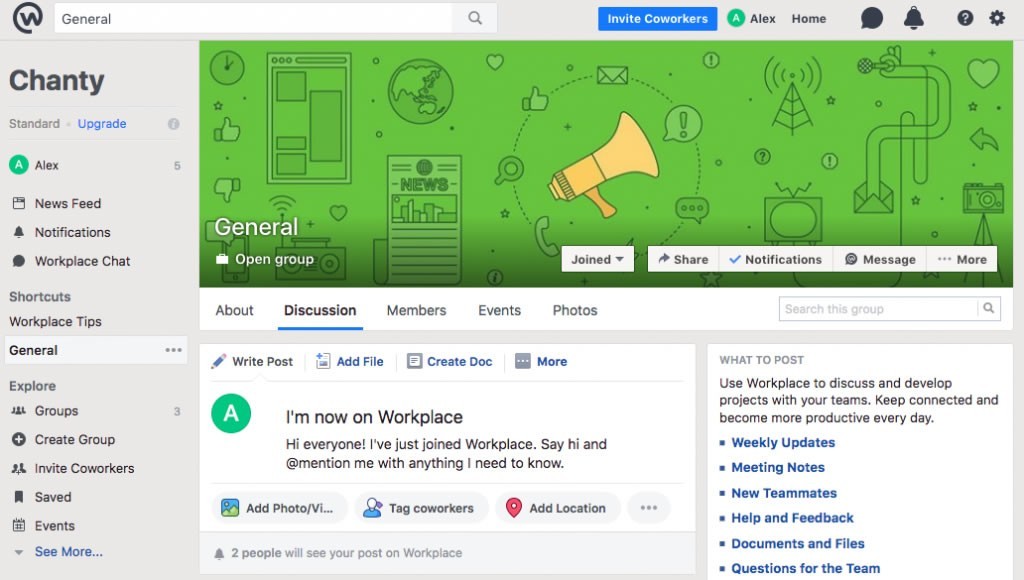Insight Blog
Agility’s perspectives on transforming the employee's experience throughout remote transformation using connected enterprise tools.
21 minutes reading time
(4212 words)
Enterprise Social Network: Enhancing Collaboration and Connectivity in Your Business in 2024
An enterprise social network can function as a go to place for remote employees to Collaborate and Connect in Your Business.
Successful workplaces thrive on effective collaboration and seamless communication. With the surge in remote work, organizations are in pursuit of a centralized communication platform that goes beyond traditional business tools. This quest ensures that employees can seamlessly connect and collaborate, irrespective of their geographical locations. This is precisely where Enterprise Social Network (ESN) tools step in as indispensable assets.
ESNs blend the advantages of public social media networks, offering features such as simultaneous updates sharing and real-time messaging. The differentiator is that ESNs furnish organizations with these benefits in a secure and confidential manner.
Research indicates that teams leveraging ESNs experience elevated knowledge sharing and collaboration across silos, outperforming teams without ESNs.
In the realm of enterprise social media, the stakes can be high, along with the number of stakeholders involved.
Social media has evolved into a critical marketing and communication tool for companies, irrespective of their size. However, managing enterprise social media diverges significantly from overseeing social media for a small business.
In the enterprise landscape, a social strategy must not only drive results aligned with the organization's overarching goals but also navigate through an intricate network of people and policies. Balancing efficiency and compliance demands while achieving tangible business outcomes is a common challenge.
The fundamental question persists: Are ESNs the right fit for your organization? Let's embark on the exploration.
What is an Enterprise Social Network?
So, what is network enterprise application also known as Employee Social Network, or Employee intranet?
An enterprise social network (ESN) serves as a private online platform, distinct from public social networks like LinkedIn, tailored for professional collaboration within a company. Particularly beneficial for organizations with a mix of remote and on-site team members, ESNs integrate various elements on a single communication platform, fostering seamless collaboration.
This comprehensive approach includes collaboration tools, instant messaging, project management, and task management.
Business social network platform typically include a variety of features, such as:
- Teamwork tools
- Real-time messaging
- Project coordination
- Task organization
In essence, an ESN serves as the ideal medium for breaking down communication barriers and encouraging collaboration across organizational silos.
By promoting open communication and idea-sharing, it not only enhances employee engagement but also stimulates creativity. When these tools are utilized collectively, the result is heightened productivity, making an enterprise social network a valuable asset for modern businesses striving for efficient teamwork. A good example is AgilityPortal enterprise social network.
The History of Enterprise Social Networking
Lets dig in to business social network platform and the history.
The emergence of enterprise social networks (ESNs), exemplified by well-known platforms like Yammer, Teams, Jive, Chatter, and Jabber, can be traced back to the early 1990s when the internet first began to connect people and foster online communities around shared interests. Notable platforms such as theGlobe.com and Geocities paved the way, offering centralized spaces for content sharing. These early online communities, initially driven by common interests, soon became a hub for a diverse range of users, including advertisers.
As these social networks gained immense popularity in the consumer world, influencing platforms like Facebook, Twitter, and LinkedIn, a parallel trend emerged in the corporate sphere.
Recognizing the potential for enhanced internal communication and collaboration, enterprise-focused social networks like Yammer and Jabber began to surface.
Yammer, for instance, was designed as an internal business-oriented social network, akin to Facebook but tailored for workplace use. Its user-friendly interface allowed seamless communication among colleagues, featuring an activity feed to showcase the latest actions and content. The appeal for businesses was evident – a unified platform for communication and collaboration that facilitated keeping all employees informed and engaged.
The evolution continued as Microsoft recognized the value of this model, leading to its acquisition of Yammer in 2012.
Subsequently, Microsoft leveraged this foundation to develop Microsoft Teams, further solidifying the role of enterprise social networks as integral tools for fostering efficient communication and collaboration within organizations.
Why is an Enterprise Social Network Important for a Business?
In the dynamic landscape of modern business, an Enterprise Social Network (ESN) has become a crucial asset, revolutionizing the way organizations communicate, collaborate, and operate. One fundamental reason behind the importance of an ESN lies in its ability to break down communication barriers within a company. By providing a centralized and accessible platform for employees to interact, share ideas, and collaborate in real-time, an ESN promotes a culture of open communication and connectivity.
Furthermore, an ESN plays a pivotal role in enhancing employee engagement. Through features like discussion forums, instant messaging, and collaborative project spaces, it creates a virtual space where employees feel connected and involved. This sense of engagement fosters a positive work environment, encouraging employees to contribute their ideas, insights, and expertise, ultimately driving innovation and creativity within the organization.
The collaborative nature of an ESN also contributes significantly to improved productivity. By consolidating communication tools, project management, and task tracking into a unified platform, it streamlines workflows and facilitates seamless information sharing. This not only reduces the likelihood of information silos but also ensures that teams stay aligned, leading to more efficient and coordinated efforts across the organization.
Finally, an ESN serves as a valuable repository of institutional knowledge. As employees share information, best practices, and insights on the platform, it creates a searchable knowledge base that can be tapped into by individuals across different departments and hierarchies.
This knowledge-sharing aspect not only empowers employees with readily accessible information but also contributes to continuous learning and development within the organization. Overall, an Enterprise Social Network is indispensable in today's business landscape, fostering collaboration, engagement, productivity, and knowledge-sharing for a thriving and interconnected workplace.
You might be considering that this bears a resemblance to a traditional intranet, so what sets them apart? Primarily, intranets serve as document management systems, centered around content and information management, facilitating streamlined file and project sharing among users.
On the flip side, Enterprise Social Networks (ESNs) place a greater emphasis on the social dynamics of work, focusing on conversations and networking.
Recognizing the significance of both functions in fostering a robust team and a thriving workspace, these tools are often employed in tandem, creating a more comprehensive or "complete" internal network. This holistic approach should be the objective for companies transitioning to a digital environment.
Follow us and access great exclusive content everyday: Follow us on Google News
What Are the Benefits of using a Enterprise Social Media Software?
Discover the advantages of integrating a enterprise social media software into your workplace:
Centralizes Knowledge Sharing
An enterprise social network serves as a robust knowledge base, streamlining information access and file retrieval for all employees. This transformation not only simplifies document management but also amplifies overall work efficiency. Leveraging the ESN for knowledge sharing goes beyond just organizational benefits; it significantly contributes to an efficient onboarding process, providing new team members with swift access to vital information in a centralized location.
Benefits:
- Enhanced Document Management: The ESN's centralized approach ensures that documents and information are readily available, reducing the time spent searching for essential data.
- Increased Collaboration: By providing a common platform for knowledge sharing, an ESN promotes collaboration among team members, fostering a culture of shared insights and expertise.
- Improved Onboarding Experience: New hires can quickly integrate into the organization by accessing a centralized repository of information, expediting their onboarding process.
- Time Efficiency: Streamlining access to information leads to increased efficiency, minimizing delays caused by searching for scattered data across various platforms.
- Consistent Information Access: The ESN ensures that all employees have access to the same pool of information, promoting consistency in communication and decision-making.
This approach not only aligns teams with a unified source of knowledge but also empowers individuals to contribute and access information seamlessly, ultimately enhancing the overall productivity and effectiveness of the workforce.
Improves Internal Communication
Say goodbye to prolonged email threads and cluttered inboxes by leveraging the power of an ESN. Real-time chat features and succinct, threaded conversations revolutionize communication, offering a transparent feed accessible to all. The organizational transparency inherent in these feeds nurtures collaboration, empowering employees to support each other on shared projects or issues. Robust search functionality further enhances these collaborative efforts.
Benefits:
- Efficient Communication: Real-time chat features enable instant communication, eliminating the need for lengthy email exchanges and ensuring prompt responses.
- Clear and Concise Conversations: Threaded conversations provide a structured and organized way to communicate, reducing confusion and facilitating a clearer understanding of discussions.
- Transparency Across the Organization: The accessibility of communication feeds to everyone fosters a transparent work environment, promoting open communication and collaboration.
- Project and Issue Assistance: Employees can readily assist each other on shared projects or address common issues, leveraging the collective knowledge and expertise within the organization.
- Enhanced Collaboration: The ESN's features encourage collaboration by providing a centralized space for discussions, updates, and information sharing.
- Efficient Problem Resolution: The integration of robust search functionality simplifies the process of finding relevant information, aiding in efficient issue resolution and decision-making.
By adopting an ESN for communication, organizations not only streamline their internal interactions but also create a collaborative and transparent culture that promotes efficiency and knowledge-sharing among employees.
Increases Employee Productivity
Navigating the challenge of employees juggling multiple tech tools is a common hurdle in many workplaces, resulting in continuous context-switching and time wastage. However, the integration of an enterprise social network (ESN) with widely-used work tools such as Slack, Google Drive, and Microsoft SharePoint offers an effective solution to this issue. This seamless integration consolidates various tools into one accessible platform, fostering enhanced productivity and efficiency among employees. The need for constant tool-switching throughout the day is eliminated, streamlining workflow and optimizing the overall work experience.
Benefits:
- Reduced Context-Switching: Integration with popular work tools minimizes the need for employees to switch between multiple applications, allowing them to focus on tasks without interruptions.
- Improved Workflow: The consolidation of tools in one platform streamlines workflow processes, creating a cohesive and efficient working environment.
- Enhanced Collaboration: Integration with collaboration tools like Slack promotes seamless communication and cooperation among team members, fostering a collaborative culture.
- Time Efficiency: By eliminating the necessity for constant tool-switching, employees can allocate more time to productive tasks, leading to increased overall efficiency.
- Unified Access: Employees can access essential tools and resources from a centralized platform, ensuring uniform access to information and facilitating a more cohesive work experience.
- Simplified Training: The integration of tools within an ESN simplifies training processes, as employees only need to familiarize themselves with one platform rather than multiple disparate applications.
The harmonious integration of an ESN with popular work tools not only streamlines operations but also contributes to a more effective and collaborative work environment, ultimately enhancing the overall efficiency of the workforce.
Major Limitations of an Enterprise Social Network
Social Media Distractions
While ESNs are designed for internal collaboration, they can become distracting if not managed effectively. The primary objective of these networks is to enhance team communication and collaboration. However, excessive usage can lead to a decline in overall productivity. Unregulated spontaneous conversations can be particularly distracting. Establishing clear rules and guidelines for ESN usage is essential to prevent distraction and maintain focus on core tasks.
Messages and Notifications Management
Real-time communication through ESNs is a key advantage, but it comes with challenges. Employees may face frustration and overwhelm if they receive work-related messages at unconventional hours. To address this, organizations should empower employees to manage notifications based on their availability. Providing flexibility to restrict notifications during non-working hours ensures a more balanced work-life integration and prevents burnout.
Siloed Conversations
The proliferation of various tools, including ESNs, collaboration platforms, and project management tools, can lead to siloed conversations. Discussions initiated in one tool may transition to another, causing confusion. Employees might find themselves searching across different tools for pertinent information. To mitigate this, organizations should seek integrated solutions that seamlessly combine ESN features with project management, document management, and collaboration tools.
Effective Utilization of ESNs
The success of ESNs lies in their seamless integration with existing IT infrastructure. Introducing additional tools can result in confusion and reduced productivity due to constant context switching. A holistic digital workplace platform, like Kissflow, offers a comprehensive solution. It integrates essential features such as project management, knowledge repository, centralized cloud storage, public and private communication channels, and a streamlined ESN. This consolidation ensures a cohesive and efficient workflow for employees, minimizing disruptions and maximizing the benefits of ESNs within the organizational framework.
Key features of an Enterprise Social Network Software
Enterprise social network (ESN) software is a private social networking platform designed for organizations to improve communication, collaboration, and knowledge sharing among employees. Here are some of the key features of ESN software:
Communication
In the realm of Enterprise Social Network Software, various features facilitate seamless communication and collaboration among employees:
- Posts and Updates: Team members can share news, updates, and innovative ideas through posts and status updates, fostering a dynamic exchange of information.
- Comments and Likes: The interactive nature of ESNs allows employees to engage with posts by adding comments, expressing appreciation through likes, and easily sharing valuable content with their colleagues.
- Groups and Communities: ESNs provide a platform for employees to join groups and communities aligned with their interests, ongoing projects, or specific departments, promoting a sense of community and collaboration.
- Instant Messaging and Chat: Real-time communication is enhanced through instant messaging and chat features, allowing employees to connect swiftly and exchange information promptly.
- Video Conferencing Integration: ESN software seamlessly integrates with video conferencing tools, enabling employees to engage in face-to-face interactions, fostering a more personal and connected work environment, particularly when working from different locations.
These features collectively contribute to an enriched collaborative experience within an organization, promoting effective communication and team synergy.
Collaboration
Within Enterprise Social Network Software, a suite of features enhances document sharing and collaborative efforts among employees:
- Document Sharing and Collaboration: Team members can seamlessly share documents, files, and various resources with their colleagues. The real-time collaboration functionality enables simultaneous work on shared documents, promoting efficiency and collective input.
- Wikis: Integrated wikis within ESN software serve as collaborative platforms, allowing employees to collectively create and edit content. This collaborative approach fosters a dynamic environment where knowledge and information can be collectively curated and refined.
- Project Management Tools: Some ESN software encompasses robust project management tools. These tools empower employees to monitor project progress, allocate tasks, and engage in collaborative efforts to ensure successful project outcomes.
- Task Management: ESN platforms often feature dedicated task management tools. Employees can easily create, organize, and monitor tasks, establish deadlines, and track their progress. This streamlined approach to task management enhances organizational efficiency and ensures timely completion of projects and assignments.
These features collectively contribute to a comprehensive collaborative ecosystem within the organization, facilitating seamless document management and project coordination.
Knowledge sharing
Incorporating a range of collaborative features, Enterprise Social Network (ESN) software enhances knowledge-sharing and connectivity among employees:
- Expert Directories: ESN platforms offer expert directories, streamlining the process for employees to identify and connect with individuals possessing specific knowledge. This resource proves invaluable in fostering a culture of expertise-sharing within the organization.
- Q&A Forums: Dedicated Q&A forums serve as interactive spaces where employees can pose questions and receive responses from their colleagues. This collaborative approach not only facilitates knowledge exchange but also encourages a supportive and informed community within the organization.
- Blogs and Microblogs: ESN software provides avenues for employees to share their insights and expertise through blogs and microblogs. This feature enables the dissemination of valuable knowledge, encourages thought leadership, and fosters a culture of open communication.
- Content Search: The platform incorporates robust content search functionality, allowing employees to efficiently search for specific information and resources within the ESN. This enhances accessibility and ensures that relevant knowledge is readily available to support organizational initiatives.
These features collectively contribute to creating a dynamic and collaborative knowledge-sharing environment, reinforcing the organization's commitment to fostering expertise, innovation, and seamless information retrieval.
Other features
In addition to the collaborative features mentioned earlier, Enterprise Social Network (ESN) software offers a diverse range of functionalities designed to enhance organizational dynamics:
- Employee Recognition: Recognizing and rewarding employee contributions is facilitated through ESN software. This feature encourages a positive workplace culture by acknowledging and celebrating the efforts and achievements of individuals within the organization.
- Mobile Apps: The accessibility of ESN is further enhanced through dedicated mobile apps, enabling employees to engage with the platform seamlessly using their smartphones and tablets. This ensures continuous connectivity, especially for those on the go or working remotely.
- Integration with Other Applications: ESN software offers integration capabilities with various business applications, including Customer Relationship Management (CRM) and Enterprise Resource Planning (ERP) systems. This integration enhances workflow efficiency and ensures a cohesive digital ecosystem.
These features collectively contribute to creating a dynamic and collaborative organizational environment. The selection of specific features depends on the unique needs and goals of each organization, highlighting the adaptability and customization options provided by ESN software.
You may also like: Best Apps for Employees: UPDATED 2022 – A Complete Guide
How to use an enterprise social network effectively
As emphasized earlier, a critical aspect of implementing an Enterprise Social Network (ESN) across your business is ensuring its seamless integration into your teams' workflow. Many ESNs come equipped with document sharing, task management tools, and chat functions. However, certain organizations may find that they can harness the advantages of an enterprise social network within an existing collaborative workplace, such as AgilityPortal, that already possesses project management capabilities.
At its essence, AgilityPortal serves as a workspace where organizations can generate, organize, and share team knowledge and project documentation. Beyond its foundational features, AgilityPortal facilitates two-way conversations and collaboration around content. Through its prominent feed, offering a glimpse of noteworthy content from across the company, teams can stay abreast of the latest announcements from their peers.
For instance, the global non-profit Oxfam leverages AgilityPortal as an enterprise social network, encouraging team members to share personal and professional achievements with the entire company. These shared stories, often in the form of internal blog posts, elicit comments of support or provoke follow-up questions, fostering a profound sense of connectedness and community among team members.
Before embarking on ESN implementation, it's imperative to address questions about the ownership and maintenance of the network within your organization. Some companies choose to centralize ownership and moderation within a specific team, like IT or HR. In contrast, others witness success by distributing ownership across the entire team. Oxfam, for instance, had IT set up AgilityPortal internally, establishing operational principles around usage, etiquette, and communication best practices that the entire company embraced.
Ultimately, the effectiveness of the chosen platform hinges on its adoption by your team. If the platform is cumbersome, achieving the desired uptake becomes challenging. The ideal platform should be user-friendly, enjoyable, and non-intrusive, aligning seamlessly with your team's communication needs, document sharing, task management, and collaborative efforts. Minimizing context-switching enhances your team's ability to concentrate on details, fostering productivity with minimal disruptions.
Avoid drawbacks of ESNs and Upgrade to a Powerful Intranet
As evident, the strengths of ESNs play a crucial role in shaping the digital workspace by introducing social media-inspired features such as enhanced employee engagement, fortified company culture, and streamlined communication. In contrast, traditional intranets excel in fostering collaboration and knowledge management.
For those seeking to revamp and simplify their company's communication channels, opting for a modernized intranet system offers the best of both worlds. This approach promotes a well-rounded platform that encourages employees to produce their finest work.
Regardless of your team's geographical dispersion, AgilityPortal serves as a unified space for everyone to convene, forge deeper connections, and collaborate seamlessly for optimal outcomes. Happy and engaged employees contribute to increased productivity and efficiency, ultimately benefiting your bottom line.
If you're eager to witness these results firsthand, try out our demo and embark on the journey of upgrading your intranet!
3 of The best enterprise social networking solutions for remote teams
Exploring the diverse landscape of enterprise social networking solutions is crucial for selecting the most suitable platform tailored to your organization's needs. Several standout options offer a range of features and capabilities, empowering you to foster seamless collaboration and communication within your workplace.
AgilityPortal from Agility Online Ltd
AgilityPortal stands out as a comprehensive solution that seamlessly combines employee intranet, knowledge management, and enterprise social network functionalities into a single, user-friendly interface.
The platform aims to enhance team happiness by facilitating efficient collaboration through its unique features. Spaces serve as collaborative spaces where team members can share posts and engage through reactions, emojis, and comments. The People feature functions as an employee directory, providing detailed information about colleagues, fostering seamless collaboration across geographical boundaries.
Personalized home pages elevate each employee's intranet experience, offering quick access to the most relevant Channels, feeds, and content upon logging in. Advanced Analytics features empower organizations to gain insights into content accessibility and identify influential contributors within the organization. Key networking features include posts, comments, likes, shares, and tags, creating a dynamic and interactive environment. The platform also ensures accessibility through a mobile app, facilitating on-the-go collaboration.
AgilityPortal commitment to deepening collaboration and communication within organizations.
- Employee Intranet: A centralized hub serving as the epicenter for your company's internal communication, documents, and resources, AgilityPortal provides a robust platform for streamlined collaboration and efficient resource management.
- News and Announcements: Keep your workforce informed and engaged by sharing company news, updates, and announcements in a centralized location accessible to all employees.
- Document Management: Simplify document handling with a comprehensive solution to store, share, and manage all your company's documents efficiently, ensuring seamless access for authorized users.
- Collaboration Tools: Foster teamwork and project collaboration with diverse tools such as wikis, forums, and chat functionalities, empowering teams to work together seamlessly.
- E-learning: Elevate your workforce's skills and knowledge through online courses and learning materials, facilitating continuous learning and development for your employees.
- Surveys and Polls: Harness the collective insights of your workforce by conducting surveys and polls, enabling data-driven decision-making and enhancing employee engagement.
- Events Calendar: Effortlessly manage and track company events through an integrated calendar, ensuring a well-organized schedule for all employees.
- Social Recognition: Acknowledge and reward employee achievements with the social recognition feature, promoting a positive and appreciative work culture.
- Mobile App: Stay connected and access AgilityPortal on the go with the mobile app, providing flexibility and convenience for employees who are always on the move.
Workplace from Meta
Workplace, developed by Meta (formerly Facebook), stands out as a collaborative platform tailored for the corporate environment. Leveraging an interface akin to Facebook, it offers a sense of familiarity to users. Employees can seamlessly share posts, photos, videos, or links, engaging in interactive discussions through comments and reactions.
To enhance communication and information accessibility, the creation of groups for specific departments or project teams ensures that everyone stays informed and connected. The employee directory and private messaging functionalities facilitate efficient organization-wide searches and quick communication with any individual within the company.
Key networking features of Workplace include:
- Newsfeed
- Employee directory
- Facebook-like posts, comments, and reactions
- Live video broadcasting
- Mobile app
These features collectively contribute to a user-friendly and dynamic collaborative environment within the business realm.
SharePoint from Microsoft
Wrapping up
Microsoft SharePoint stands out as a reliable choice among intranet software solutions. It provides a shared home portal, enabling seamless resource sharing among colleagues. Teams can be segmented into distinct divisions for private communication, and each division gains access to a visual timeline and calendar, facilitating efficient project time estimation and collaboration.
Key features:
- Version Control: Keep track of document changes, revert to previous versions, and maintain a transparent history of edits.
- Collaborative Editing: Simultaneously collaborate on documents with colleagues, view real-time changes, and co-author content effectively.
- Advanced Permission Settings: Exercise precise control over file access, editing, and sharing permissions, ensuring information security and compliance.
- Intranet and Teams Sites:
- Customizable Team Sites: Establish dedicated sites for projects, departments, or teams, fostering information sharing, task collaboration, and workflow management.
- Rich Content Creation: Create visually appealing and engaging pages effortlessly, incorporating text, images, videos, web parts, and more without the need for coding expertise.
- Engaging Communication: Disseminate news, announcements, and updates to targeted audiences through web parts, notifications, and social features.
- Personalized Experiences: Tailor content and views based on user roles and interests, providing a personalized and relevant experience.
For small to medium-sized businesses (SMBs), the basic plan proves beneficial, offering essential features such as OneDrive, Lists, and SharePoint functionalities. Businesses requiring additional scalability can explore Office 365, which provides extended applications to meet broader business needs.
Have a look at the different Products In Enterprise Social Networking Applications on Gartner.
Free ebook: How To Get Your Intranet Off The Ground
Download our eBook: How To Get Your Intranet Off The Ground
Categories
Blog
(2596)
Business Management
(318)
Employee Engagement
(206)
Digital Transformation
(173)
Intranets
(119)
Growth
(118)
Remote Work
(61)
Sales
(48)
Collaboration
(37)
Culture
(29)
Project management
(29)
Customer Experience
(26)
Knowledge Management
(21)
Leadership
(20)
Comparisons
(5)
Ready to learn more? 👍
One platform to optimize, manage and track all of your teams. Your new digital workplace is a click away. 🚀
Free for 14 days, no credit card required.



















